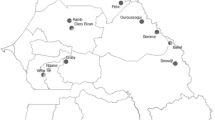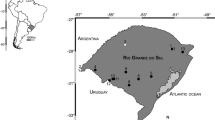Abstract
Some tropical Bignoniaceae form sporophytic apomictic polyploid complexes are similar to better studied temperate plants. Handroanthus ochraceus is a widely distributed Neotropical savanna tree with both monoembryonic/self-sterile, and polyembryonic/apomictic and self-fertile populations, but lacking chromosome number and morphological comparative studies. We tested if monoembryonic/non-apomictic and polyembryonic/apomictic populations differed in ploidy and morphological features, as a basis to understand evolution and biogeography of these plants. Chromosome number and embryo number per seed were investigated, and uni- and multivariate analyses of flower and leaf morphology were done for five populations of H. ochraceus. We found two pure monoembryonic diploid (2n = 40), and one pure polyembryonic (62–94% of polyembryonic seeds) tetraploid population (2n = 80). One of the diploid populations presented only one individual with 3.2% polyembryonic seeds and was considered a non-apomictic population. Another population showed predominantly polyembryonic (27–66% of polyembryonic seeds) tetraploid individuals, but one diploid individual with 2% of polyembryonic seeds, and was considered a mixed apomictic and non-apomictic population. Morphological analyses confirmed breeding system clusters, and that stigma width, as well as pollen grain area, was consistently larger in polyembryonic populations. Polyploid plants showed larger cells, as well as larger organs and other distinctive features, which will be useful to identify apomictic populations and to future taxonomic discussions. The species can be considered an agamic complex with apomixis associated with neopolyploidy. This trend is also found in other tropical sporophytic apomictics, contrasting with the usual reports linking diploidy or paleopolyploidy to this kind of apomictics.






Similar content being viewed by others
References
Alves MF, Duarte MO, Oliveira PE, Sampaio DS (2013) Self-sterility in the hexaploid Handroanthus serratifolius (Bignoniaceae) the national flower of Brazil. Acta Bot Brasil 27:714–722. https://doi.org/10.1590/s0102-33062013000400010
Alves MF, Duarte MO, Bittencourt NS, Oliveira PE, Sampaio DS (2016) Sporophytic apomixis in polyembryonic Handroanthus serratifolius (Vahl) S. Grose (Bignoniaceae) characterizes the species as an agamic polyploid complex. Pl Syst Evol 302:651–659. https://doi.org/10.1007/s00606-016-1291-9
Asker SE, Jerling L (1992) Apomixis in plants. CRC Press, Boca Raton
Balao F, Herrera J, Talavera S (2011) Phenotypic consequences of polyploidy and genome size at the microevolutionary scale: a multivariate morphological approach. New Phytol 192:256–265. https://doi.org/10.1111/j.1469-8137.2011.03787.x
Barros MG (2001) Pollination ecology of Tabebuia alba (Manso) Benth and Hook and T. ochracea (Cham.). Standl. (Bignonenaceae) in central Brazil Cerrado vegetation. Revista Brasil Bot 24:255–261. https://doi.org/10.1590/S0100-84042001000300003
Bawa KS (1974) Breeding systems of three species of lowland tropical community. Evolution 28:85–92. https://doi.org/10.1111/j.1558-5646.1974.tb00729.x
Beest MTE, Le Roux JJ, Richardson DM, Brysting AK, Suda J, Kubesova M, Pysek P (2012) The more the better? The role of polyploidy in facilitating plant invasions. Ann Bot (Oxford) 109:19–45. https://doi.org/10.1093/aob/mcr277
Bittencourt NS, Moraes CIG (2010) Self-fertility and polyembryony in South American yellow trumpet trees (Handroanthus chrysotrichus and H. ochraceus, Bignoniaceae): a histological study of post-pollination events. Pl Syst Evol 288:59–76. https://doi.org/10.1007/s00606-010-0313-2
Bittencourt NS, Semir J (2005) Late-acting self-incompatibility and other breeding systems in Tabebuia (Bignoniaceae). Int J Pl Sci 166:493–506. https://doi.org/10.1086/428758
Bray JR, Curtis JT (1957) An ordination of the upland forest communities of southern Wisconsin. Ecol Monogr 4:325–349. https://doi.org/10.2307/1942268
Carman JG (1997) Asynchronous expression of duplicate genes in angiosperms may cause apomixis, bispory, tetraspory, and polyembryony. Biol J Linn Soc 61:51–94. https://doi.org/10.1111/j.1095-8312.1997.tb01778.x
Carman JG (2007) Do duplicate genes cause apomixis? In: Hörland E, Grossniklaus U, van Dijk PJ, Sharbel TF (eds) Apomixis: evolution, mechanisms and perspectives. A.R.G. Gantner, Rugell, pp 63–91
Collevatti RG, Dornelas MC (2016) Clues to the evolution of genome size and chromosome number in Tabebuia alliance (Bignoniaceae). Pl Syst Evol 302:601–607. https://doi.org/10.1007/s00606-016-1280-z
Collins TJ (2007) ImageJ for microscopy. Biotechniques 43:25–30
Costa ME, Sampaio DS, Paoli AAS, Leite SCAL (2004) Poliembrionia e aspectos da embriogênese em Tabebuia ochracea (Chamisso) Standley (Bignoniaceae). Revista Brasil Bot 27:395–406. https://doi.org/10.1590/S0100-84042004000200017
Dafni A, Kevan PG, Husband BC (2005) Practical pollination ecology. Enviroquest, Cambridge
Duffy KJ, Scopece G, Cozzolino S, Fay MF, Smith MJ, Stout JC (2009) Ecology and genetic diversity of the dense-flowered orchid, Neotinea maculata, at the centre and edge of its range. Ann Bot (Oxford) 104:507–516. https://doi.org/10.1093/aob/mcn200
Firetti-Leggieri F, Costa IR, Forni-Martins ER, Lohmann LG, Semir J (2011) Chromosome studies in Bignonieae (Bignoniaceae): the first records of polyploidy in Anemopaegma Mart. ex Meisn. Cytologia 76:185–191. https://doi.org/10.1508/cytologia.76.185
Firetti-Leggieri F, Lohmann LG, Alcântara S, Costa IR, Semir J (2013) Polyploidy and polyembryony in Anemopaegma (Bignonieae, Bignoniaceae). Pl Reprod 26:43–53. https://doi.org/10.1007/s00497-012-0206-3
Gentry AH (1992) Bignoniaceae-Part. II. (Tribe Tecomae). Fl Neotrop Monogr 25:1–370. http://www.jstor.org/stable/4393739
Gibbs PE, Bianchi MB (1993) Post-pollination events in species of Chorisia (Bombacaceae) and Tabebuia (Bignoniaceae) with late-acting self-incompatibility. Bot Acta 106:64–67. https://doi.org/10.1111/j.1438-8677.1993.tb00339.x
Goldblatt P, Gentry AH (1979) Cytology of Bignoniaceae. Bot Not 132:475–482
Gower JC (1971) A general coefficient of similarity and some of its properties. Biometrics 27:857–871. https://doi.org/10.2307/2528823
Guerra M (1983) O uso do Giemsa em citogenética vegetal-comparação entre a coloração simples e o bandeamento. Ci & Cult 35:190–193
Guerra NA, Natera RM (2007) Chromosome numbers three Tabebuia species (Bignonaceae). Nordic J Bot 25:359–360. https://doi.org/10.1111/j.0107-055X.2008.00011.x
Hojsgaard D, Klatt S, Baier R, Carman JG, Hörandl E (2014) Taxonomy and biogeography of apomixis in angiosperms and associated biodiversity characteristics. Crit Rev Pl Sci 33:414–427. https://doi.org/10.1080/07352689.2014.898488
Husband BC, Ozimec B, Martin SL, Pollock L (2008) Mating consequences of polyploid evolution in flowering plants: current trends and insights from synthetic polyploids. Int J Pl Sci 169:195–206. https://doi.org/10.1086/523367
Koltunow AM (1993) Apomixis: embryo sacs and embryos formed without meiosis or fertilization in ovules. Pl Cell 5:1425–1437. https://doi.org/10.1105/tpc.5.10.1425
Marinho RC, Mendes-Rodrigues C, Bonetti AM, Oliveira PE (2014) Pollen and stomata morphometrics and polyploidy in Eriotecha (Malvaceae-Bombacoideae). Pl Biol 16:508–511. https://doi.org/10.1111/plb.12135
McCune B, Mefford MJ (2011) PC-ORD: multivariate analysis of ecological data 6.0. MjM Software, Oregon
Mendes-Rodrigues C, Carmo-Oliveira R, Talavera S, Arista M, Ortiz PL, Oliveira PE (2005) Polyembryony and apomixis in Eriotheca pubescens (Malvaceae–Bombacoideae). Pl Biol 7:533–540. https://doi.org/10.1055/s-2005-865852
Mendes-Rodrigues C, Sampaio DS, Costa ME, Caetano APS, Ranal MA, Bittencourt NS, Oliveira PE (2012) Polyembryony increases embryo and seedling mortality but also enhances seed individual survival in Handroanthus species (Bignoniaceae). Flora 207:264–274. https://doi.org/10.1016/j.flora.2011.10.008
Mishra MK (1997) Stomatal characteristics at different ploidy levels in Coffea L.. Ann Bot (Oxford) 80:689–692. https://doi.org/10.1006/anbo.1997.0491
Oliveira PE, Gibbs PE, Barbosa AA, Talavera S (1992) Contrasting breeding systems in two Eriotheca (Bombacaceae) species of the Brazilian cerrados. Pl Syst Evol 179:207–219. https://doi.org/10.1007/BF00937597
Olmstead RG, Zjhra ML, Lohmann LG, Grose SO, Eckert AJ (2009) A molecular phylogeny and classification of Bignoniaceae. Amer J Bot 96:1731–1743. https://doi.org/10.3732/ajb.0900004
Otto SP, Whitton J (2000) Polyploid incidence and evolution. Annual Rev Genet 34:401–437. https://doi.org/10.1146/annurev.genet.34.1.401
Petit C, Bretagnolle F, Fleber F (1999) Evolutionary consequences of diploid-polyploid hybrid zones in wild species. Trends Ecol Evol 14:1–6. https://doi.org/10.1016/S0169-5347(99)01608-0
Piazzano M (1998) Números cromosómicos en Bignoniaceae de Argentina. Kurtziana 26:179–189
Piazzano M, Las Peñas ML, Chiarini F, Bernadello G (2015) Karyotypes and DNA content in Bignoniaceae. Caryologia 68:175–183. https://doi.org/10.1080/00087114.2015.1032606
Radford AE (1986) Fundamentals of plant systematics. Harper and Row Publishers, New York
Rocha MC, Gonçalves LSA, Rodrigues R, Silva PRA, Carmo MGF, Abboud ACS (2010) Uso do algoritmo de Gower na determinação da divergência genética entre acessos de tomateiro do grupo cereja. Acta Sci Agron 32:423–431. https://doi.org/10.4025/actasciagron.v32i3.4888
Sampaio DS, Bittencourt NS, Oliveira PE (2013a) Mating in the pseudogamic apomictic Anemopaegma acutifolium DC: another case of pseudo-self-compatibility in Bignoniaceae? Pl Biol 15:919–924. https://doi.org/10.1111/j.1438-8677.2012.00692.x
Sampaio DS, Bittencourt NS, Oliveira PE (2013b) Sporophytic apomixis in polyploid Anemopaegma species (Bignoniaceae) from Central Brazil. Bot J Linn Soc 173:77–91. https://doi.org/10.1111/boj.12076
Shepherd GJ (2007) FITOPAC 2. Departamento de Botânica, UNICAMP, Campinas
Soltis DE, Albert VA, Leebens-Mack J, Bell CD, Paterson AH, Zheng C, Sankoff D, Pamphilis CW, Kerr Wall P, Soltis PS (2009) Polyploidy and angiosperm diversification. Amer J Bot 96:336–348. https://doi.org/10.3732/ajb.0800079
SPSS (2004) Systat version 11.0. SPSS Inc, San Francisco, Califórnia
Stebbins GL (1971) Chromosomal evolution in higher plants. J.W. Arrowsmith, Bristol
Whitton J, Sears C, Baack EJ, Otto SP (2008) The dynamic nature of apomixis in the angiosperms. Int J Pl Sci 169:169–182. https://doi.org/10.1086/523369
Zlesak DC (2009) Pollen diameter and guard cell length as predictors of ploidy in diverse rose cultivars, species and breeding lines. Floric Ornam Biotech 3:53–70
Acknowledgements
We thank Dr. Eduardo Leite Borba for critical reading of the manuscript and the two reviewers for valuable suggestions.
Funding
This work was supported by Conselho Nacional de Desenvolvimento Científico e Tecnológico (CNPq) as part of the Master’s degree of the first author in the Post-Graduate Program of Genetics and Biochemistry at Universidade Federal de Uberlândia (UFU). APO and DSS were post-doctoral fellows of Coordenação de Aperfeiçoamento de Pessoal de Nível Superior (CAPES/Pró-Doc and PNPD, respectively) in the Post-Graduate Program of Plant Biology at UFU. Some of the analyses were also supported by Fundação de Amparo à Pesquisa do Estado de Minas Gerais (FAPEMIG) and CNPq grants for PEO.
Author information
Authors and Affiliations
Corresponding author
Ethics declarations
Conflict of interest
The authors declare that they have no conflict of interest.
Ethical statement
The authors comply with all rules of the journal following the COPE guidelines; all authors have contributed and approved the final manuscript.
Additional information
Handling Editor: Hans de Jong.
Rights and permissions
About this article
Cite this article
Mendes, M.G., de Oliveira, A.P., Oliveira, P.E. et al. Sexual, apomictic and mixed populations in Handroanthus ochraceus (Bignoniaceae) polyploid complex. Plant Syst Evol 304, 817–829 (2018). https://doi.org/10.1007/s00606-018-1512-5
Received:
Accepted:
Published:
Issue Date:
DOI: https://doi.org/10.1007/s00606-018-1512-5




